Tech
Top 10 AI Business Tool to Watch Out in 2024

Top 10 AI Business Tool to Watch Out in 2024: As we step into 2024, the business world is witnessing a remarkable fusion of artificial intelligence with specialized tools. Gradually, it is transforming the way we approach commerce and strategy.
Businesses have innovative AI-driven tools that promise to transform mundane business processes and boost efficiency.
For instance, businesses are leveraging several tech tools like automated chatbots for customer services, generative AI, quote tool akin to the advanced CPQ (Configure, Price, Quote) systems, data visualization tools, and more. These tools are a game changer for businesses looking to get smarter and more efficient.
In this piece, we’ll unveil the top 10 AI-integrated business tools that redefine efficiency and accuracy in business transactions.
Let’s check them out.
#1. KAI by Kasisto
Financial service providers need interaction and strategic insight from AI, which KAI by Kasisto enables. This AI tool for business harnesses presents a conversational AI platform that responds to user needs by leveraging the intelligent conversational interface.
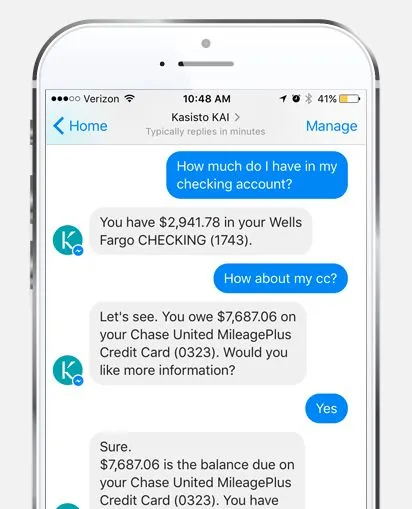
Also, as a SaaS solution, KAI offers banks and even businesses real-time analytics on customer interactions, engagement levels, and query resolution effectiveness. All these serve to monitor effective SaaS metrics like customer satisfaction scores, retention rates, and the frequency of digital assistant usage to refine customer experiences.
Here’s the roadmap to getting started.
Request a demo: Request a demo to see how KAI works to understand the platform’s capabilities and how it aligns with your company’s customer engagement strategies.
Subscribe and setup: Once satisfied, subscribe to KAI as a SaaS offering. Here, their team will help you with the initial setup, which includes integration with your existing systems and databases.
Start monitoring metrics: You get the dashboard of your business metrics with KAI that provides a bird’s-eye view of performance and customer engagement levels.
Adaptive learning: You get the ongoing interaction analysis where KAI fine-tunes its responses, making every customer experience more intuitive and personal.
#2. ChatGPT for Customer Service
ChatGPT is one of the pathbreaking AI solutions for a business that leverages an advanced AI-driven conversation assistant that transforms how businesses engage with their clients. With its sophisticated blend of natural language processing (NLP) and machine learning algorithms, it can understand customer queries, provide instant responses, and even handle complex multi-turn conversations.
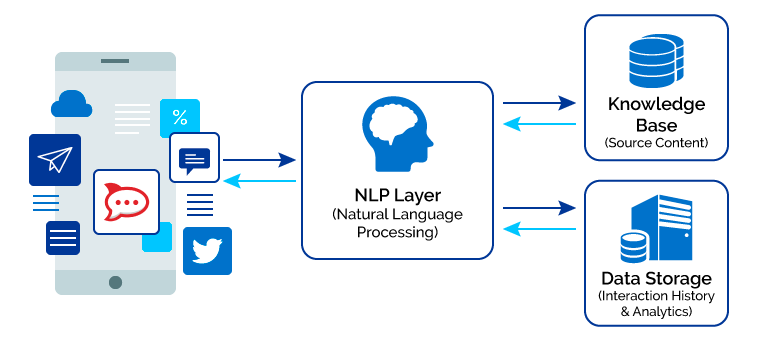
You can proceed with GPT integration into websites, apps, and other digital platforms.
Here’s how to get started.
Setup & Integration: Sign up for ChatGPT and integrate it into your website or app using a simple plugin or API. Popular platforms like WordPress, Shopify, or Wix offer dedicated ChatGPT plugins in their respective plugin or app stores.
For more customized artificial intelligence business solutions or leveraging platforms without a dedicated plugin, you’d use the ChatGPT API. This enables developers to seamlessly integrate ChatGPT into any website, app, or platform by making API calls. Access the API documentation provided by ChatGPT that guides your tech team on leveraging AI in business processes.
Training: Feed ChatGPT with your frequently asked questions and previous customer interactions to help the engine understand common queries specific to your business.
Go Live: Replace or supplement your current customer service chat with ChatGPT, which will work 24/7 without breaks!
#3. VisionAI
Ecommerce businesses looking to manage inventory effectively can use VisionAI. AI has cut costs and inefficiencies by 54%, freeing up half of the funds for expansion, and this applies to eCommerce businesses and last-mile solutions providers that need eagle-eyed assistance.
This AI solution leverages advanced image recognition to track products on shelves in real time.
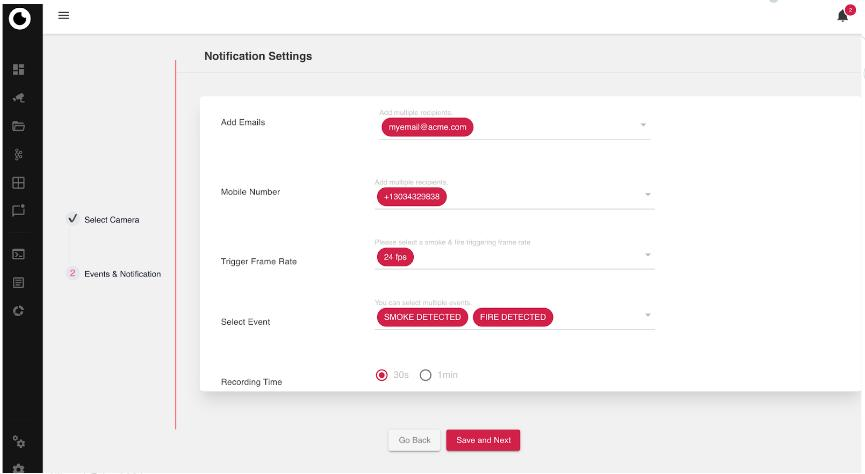
In its working, VisionAI feeds in from the cameras that are strategically placed in warehouses or stores. These cameras capture images, which are then analyzed by the AI to detect and identify products, check stock levels, and even detect misplaced items. Use this to better deal with stockouts and ensure efficient restocking.
Here’s how to get started.
Assessment: Gauge your inventory needs to understand which areas of your warehouse or store could benefit the most from VisionAI’s capabilities.
Choose a package: Now, pick the VisionAI plan that fits your needs, as some of these might offer more advanced features like predictive restocking.
Camera installation: Next, you’ll set up cameras in the identified area. Choose either VisionAI cameras or standard high-resolution cameras that are compatible.
Connect to the platform: Connect the installed cameras to the VisionAI platform, which involves a simple setup with login credentials and camera IP addresses.
Customize alerts & reporting: Lastly, set your preferences by deciding on when you like to receive alerts. For instance, when a product is running low or if an item is misplaced,
#4. EchoSense
Manufacturing businesses can now deal with unexpected downtime using EchoSense. It is an AI-driven solution that predicts when your equipment might need attention before it breaks down.
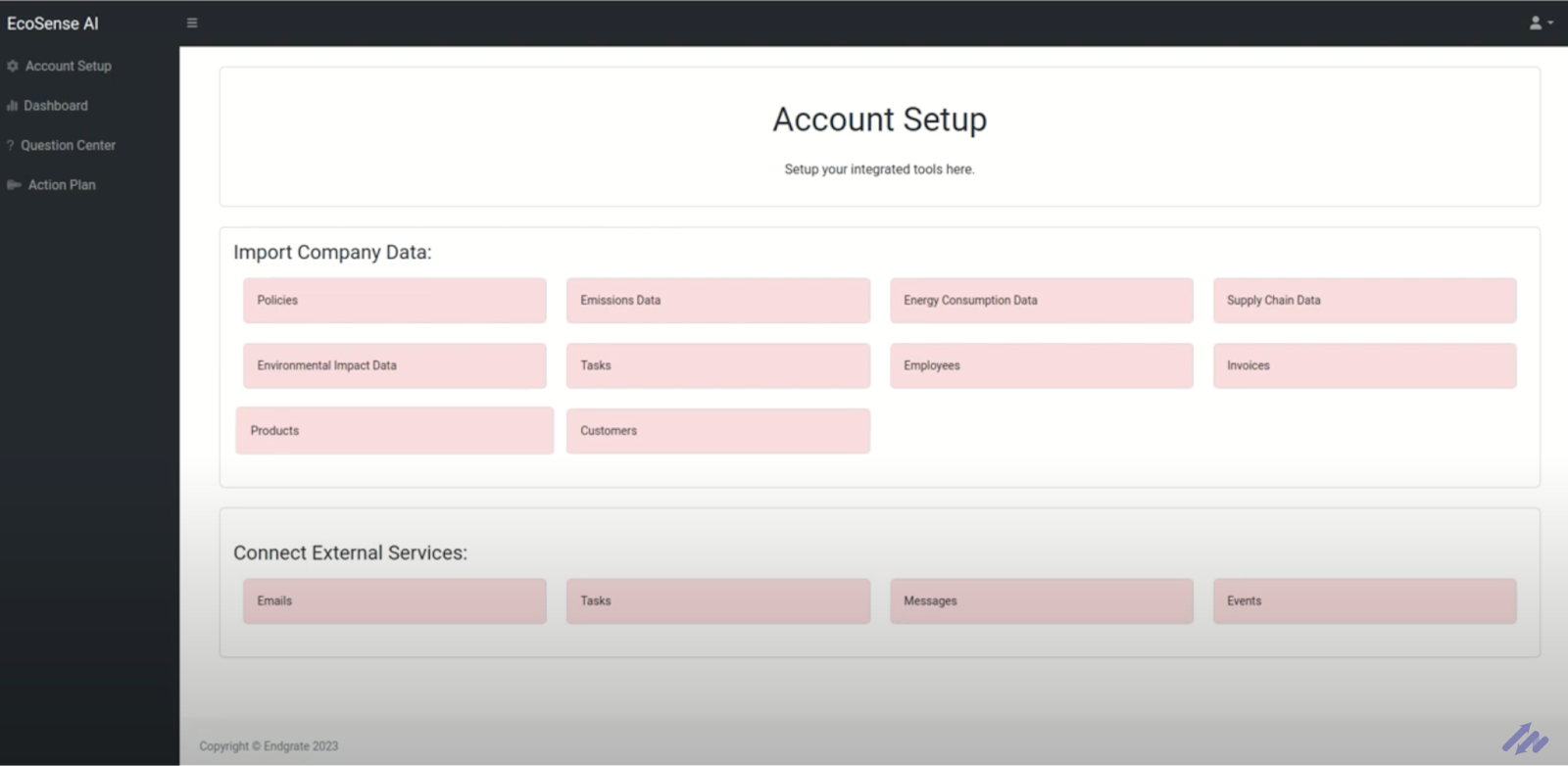
Traditional maintenance follows a schedule (e.g., every six months). But, when using Artificial Intelligence as a business solution with EchoSense, you leverage a predictive approach wherein maintenance happens when it’s truly needed. This means machinery is always in optimal condition with no wastage of resources on unnecessary checks.
Here’s how you can start.
Audit: Identify critical machines or systems that frequently have issues or are pivotal for your operations.
Sensor setup: Later, install EchoSense sensors on these machines that are typically non-invasive. You can attach these without disrupting regular operations.
Connect & sync: Link these sensors to the EchoSense dashboard that offers a central platform where you can monitor all your machinery data in real time.
Configure notifications: Set up alerts for specific events or anomalies. For instance, you can be instantly notified if a machine’s temperature goes above a safe level.
#5. MarketMinder by AirDNA
MarketMinder can be a powerful AI solution for SaaS businesses that helps make sense of market trends, consumer behaviors, and competitor actions. It provides razor-sharp insights tailored to their specific need with its advanced AI algorithms by analyzing a myriad of data sources.
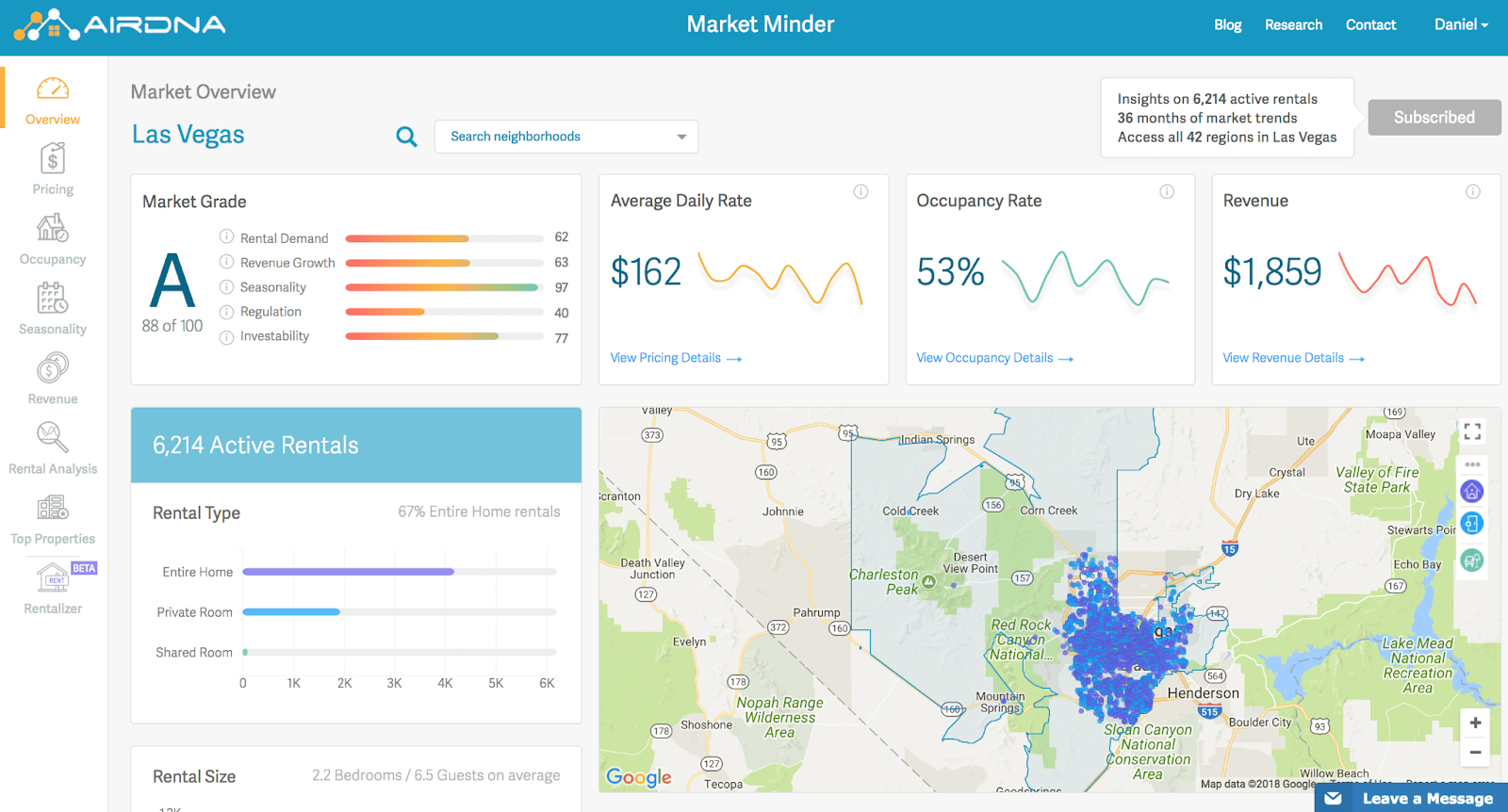
You want to make sure to take advantage of 4.9 billion who are on social media apps globally. Hence, it includes everything from social media buzz and online reviews with sales data and competitor campaigns.
Beyond just data aggregation, MarketMinder’s strength lies in its ability to connect the dots. Therefore, use it to unearth patterns that might be invisible to the human eye, providing a holistic view of the market landscape.
Here’s how you can start using it.
Business objectives: Define how you’d like to use MarketMinder. Are you looking to understand consumer sentiment, forecast sales, or track competitor activities?
Data integration: Connect MarketMinder to your existing databases, CRM systems, and any other relevant data sources to avail yourself of a comprehensive dataset to work from.
Dashboard customization: Customize the MarketMinder dashboard to highlight metrics and insights most relevant to your business goals.
Set alerts: Lastly, configure notifications for significant market events or shifts (drop in sales, reduction in social media followers, etc.), ensuring you’re always a step ahead.
#6. SaleSphere
SaleSphere is another business solution that is AI-driven to streamline the sales process. Typically, this one provides a suite of features aimed at improving sales efficiency, customer relationship management, and driving sales growth. It includes capabilities for managing customer data, automating sales workflows, tracking sales performance, and providing insights for sales strategy optimization.
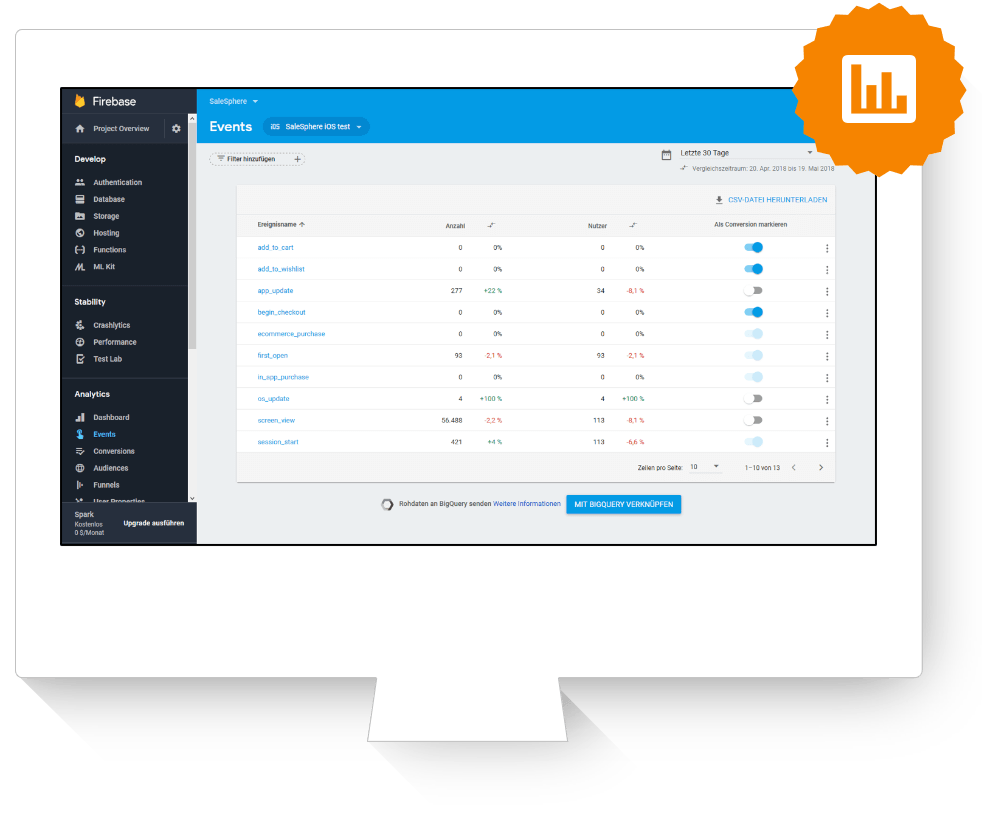
Go beyond simply leveraging the data as SaleSphere goes a step further to offer actionable insights. Instead of just showing a list of leads, it ranks them based on the likelihood of conversion and provides strategy tips for each.
Here’s how to launch your sales strategy with SaleSphere.
Integration: Link SaleSphere to your CRM and other sales tools to ensure it has access to a spectrum of data to analyze.
Sales goals: Specify your sales objectives, like targeting a new market segment, increasing repeat sales, or enhancing lead conversion rates.
AI-powered insights: SaleSphere can crunch the numbers quickly to provide you with prioritized leads and strategy recommendations for each.
Feedback loop: As sales deals close, feed this data back into SaleSphere, which ensures you smarten the AI (courtesy, ML). with each sale.
#7. Brandwatch (Ex-Crimson Hexagon)
Crimson Hexagon was a social media analytics company that provided insights into social media data through a platform known as HelioSight. It merged with Brandwatch, another leader in the digital consumer intelligence space, around 2018-2019, where the combined entity offers comprehensive digital consumer intelligence solutions.
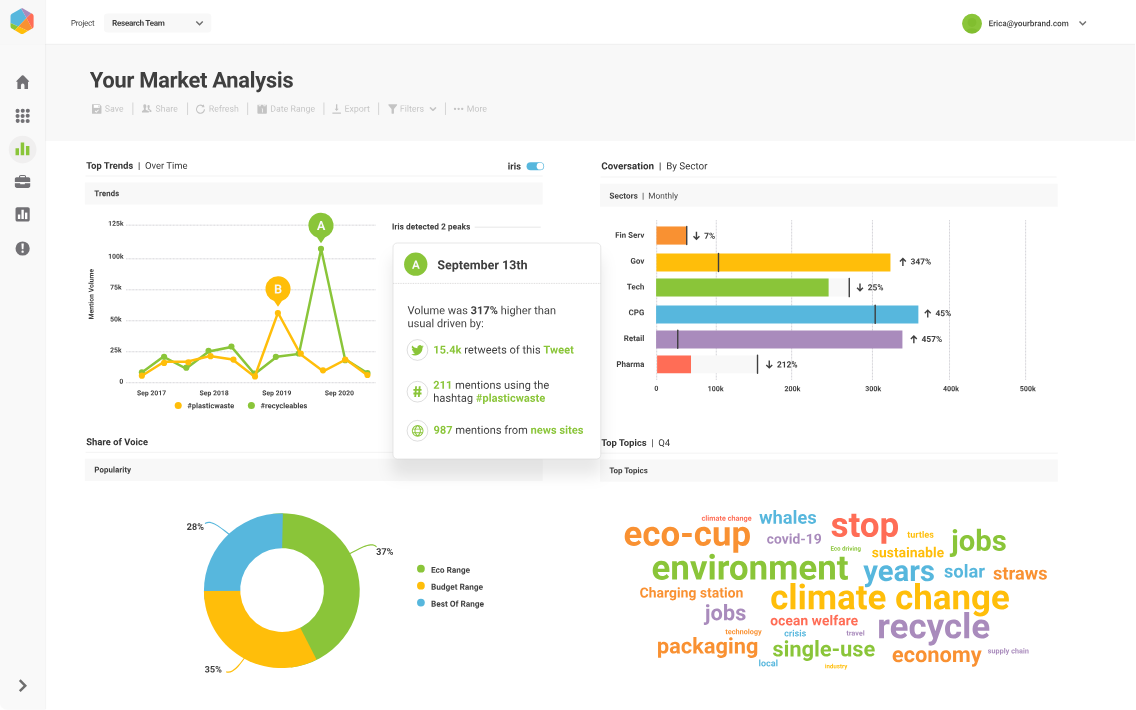
The platform is known for its robust data processing and analytics, allowing users to derive meaningful insights from complex and varied data sets. You can let the AI scan obscure forums, niche blogs, early adopters communities, and academic publications to identify emerging trends before they hit mainstream consciousness.
Let’s check out how to make it work for you.
Specify the segment: Identify the market segments or industries you want TrendTeller to monitor. The more specific you get, the better insights you’ll yield.
Deep dives: Leverage the Brandwatch’s AI to perform deep data dives that explore layers of the internet that most businesses don’t even know exist.
Analyzing trends: Receive regular reports on emerging trends with potential implications and actionable insights tailored for your business.
Adjust and act: Use insights from Brandwatch to refine your product development, marketing strategies, or overall business direction.
#8. VoxWave
VoxWave is one of the powerful AI business solutions that bring a fresh approach instead of the data-driven technologies that most AI uses. It harnesses the power of direct customer feedback by converting words and sentiments into actionable business strategies.
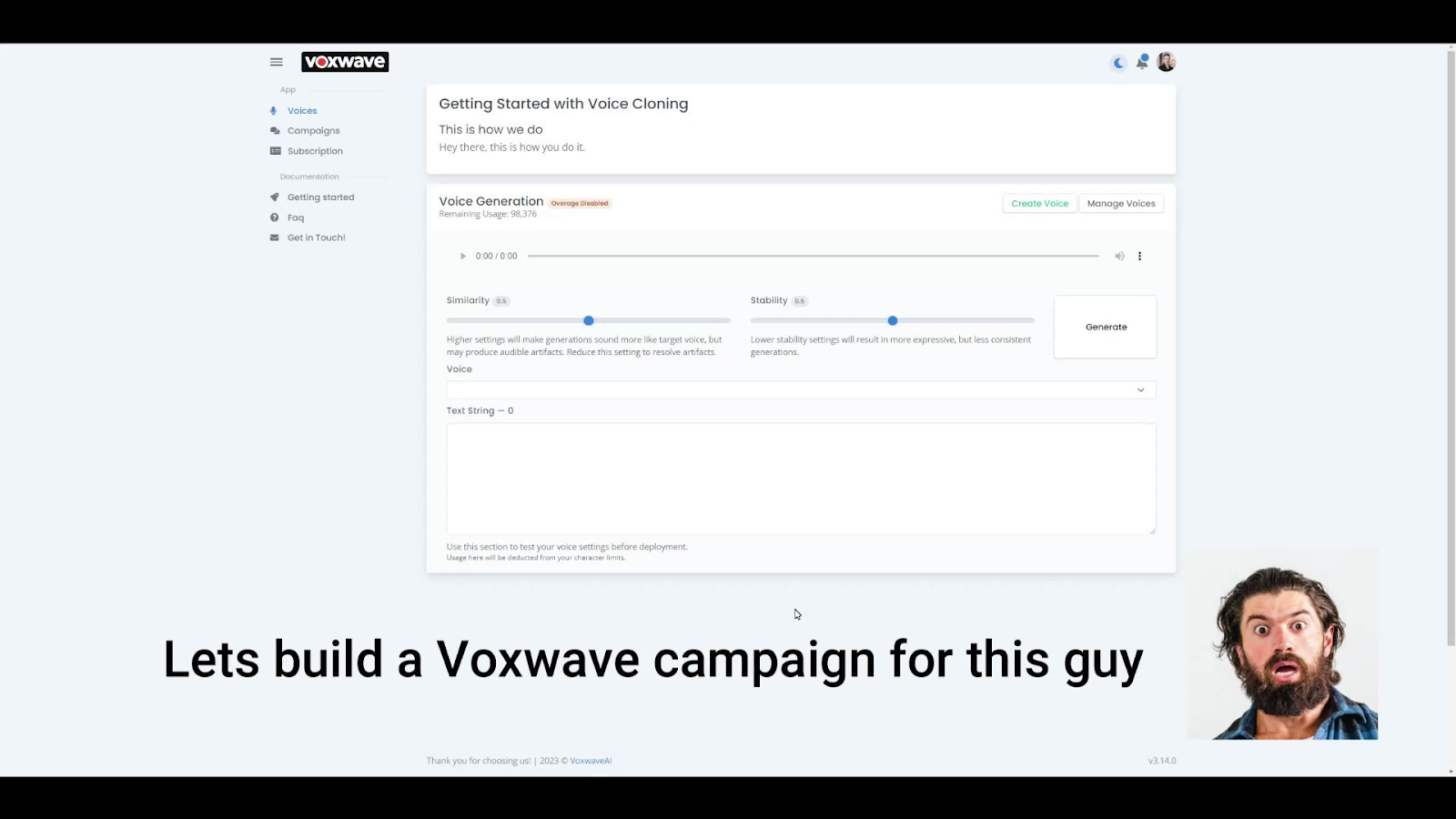
It taps into various feedback channels, from direct reviews to social media mentions and even customer service calls. The AI-driven sentiment analysis and voice recognition technologies then decipher the emotional undertones and key points of concern or appreciation from customers.
Such analysis provides a distilled, clear perspective that highlights the issues and suggests potential solutions based on historical feedback data and resolution successes.
Here’s how to craft a customer-centric path with VoxWave
Integrating channels: Start by linking VoxWave to all platforms where you receive customer feedback to ensure a comprehensive input stream.
Categorizing feedback: Next, this AI solution will categorize feedback into various buckets, such as product-related, service concerns, pricing feedback, and more. Ensure you recognize those categories and filter them for further decision-making.
Deep-dive analysis: VoxWave will then identify recurring themes and sentiments to highlight areas that are common concerns while also suggesting potential growth opportunities.
Suggesting solutions: This solution can look through the historical data to recommend strategies or changes that have proven effective in similar scenarios.
Creating feedback loop: Encourage customers to provide feedback post-resolution to refine and improve VoxWave’s suggestions.
#9. DataRobot
DataRobot is known for pioneering the field of automated machine learning (AutoML). It is designed to automate building, deploying, and maintaining machine learning models, making it easier for organizations of all sizes to implement AI solutions.
Primarily, DataRobot offers a user-friendly interface enabling data scientists and analysts to develop predictive models without extensive programming knowledge. The platform is designed to be accessible to users with varying levels of expertise in data science.
Here’s how you begin the deployment of this AI technology.
Data uploading: Upon access to this AI business solution, you must upload your dataset to the DataRobot platform. It is designed to be intuitive and guide you through the process of initiating a new project.
Model building: Select your target variable (what you’re predicting), like predictive analytics for sales forecast, customer churn prediction, etc. Next, this AI solution will automatically process your data and integrate it across data infrastructure and orchestration systems, thereby helping the team with building accurate predictive models, pipeline forecasting, competitor price analysis, and more.
This AI-driven prediction gauges future sales revenues and outcomes based on the analysis of the sales pipeline. And then, you will need to select features, choose algorithms, and tune parameters to build a range of models for prediction that help offer precise results.
Evaluation: After the models are built, evaluate them using the metrics and insights provided by DataRobot to see which data model performs best and yield insights into their accuracy and reliability.
Model deployment: Choose the best-performing model(s) and deploy them into production. DataRobot provides the infrastructure to support model deployment, monitoring, and management.
#10. EcoMetrics
As the world grows more conscious of its ecological footprint, businesses are under increasing pressure to adopt sustainable practices. Here, a solution like EcoMetrics stands at the crossroads of AI and eco-conscious business, offering insights and analytics to champion sustainable growth.
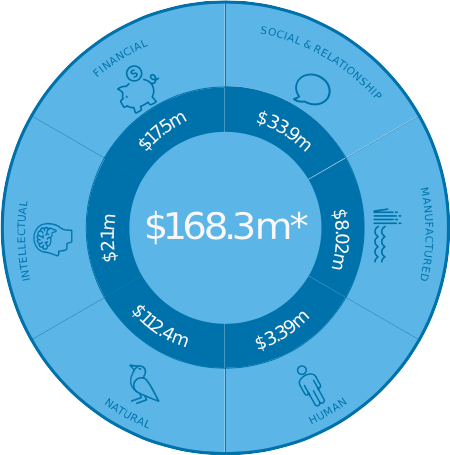
EcoMetrics aggregates data from various business touchpoints, from supply chain operations to product packaging, to evaluate the environmental impact of each facet. It does so by applying AI algorithms to suggest greener alternatives or pinpoint areas of inefficiency.
Businesses can achieve a significant reduction in wasteful expenditure and an enhanced reputation among eco-conscious consumers with EcoMetrics’ emphasis on sustainability. It’s not just about thriving as a business but ensuring the planet thrives alongside it.
Let us quickly check out how to begin this.
Pool the data: Integrate EcoMetrics with your existing operational systems to collect a comprehensive data spectrum associated with your business activities.
Eco-assessment: EcoMetrics performs a deep dive into your business practices to assess carbon footprints, water usage, waste production, and more.
Sustainable suggestions: It provides AI-driven recommendations on greener suppliers, waste reduction techniques, energy-efficient practices, and more.
Monitor & improve: Track the effectiveness of implemented changes via the EcoMetrics dashboard, ensuring your business stays on the path to sustainability.
Eco-certification: Get certifications through EcoMetrics that are based on consistent, sustainable practices that validate your eco-friendly approach to consumers.
Over to you
Equip your digital marketing team with AI that helps unlock a treasure chest for businesses. But it’s more than just fancy tech since AI solutions for small businesses are all about making jobs easier, understanding customers better, and giving that extra nudge toward success.
Therefore, integrating such solutions can help your business gear up for current challenges and also future-proof itself for evolving landscapes.
We’ve peeked at some game-changing eleven AI solutions in business here, but it is not about having the fanciest AI tools but how you use them (depending on your business needs). So, dive in, get hands-on, and see where these innovations can take your business.
After all, it’s a big world out there, and with a little AI magic, who knows what’s possible? It’s time to explore and experience it yourself.
Tech
US: A Judge Mandates that Google Allow Competing App Stores to Access Android

(VOR News) – The ruling is that Google, the greatest technology firm in the world, is required to make its Android smartphone operating system available to merchants that supply applications that are in direct rivalry with Google’s. This decision was reached by a judge in the United States of America.
The Android Play store, which is owned and operated by Google, was found to be an example of an illegal monopoly arrangement by a jury in the state of California on Monday. The finding was reached by a jury. Monday is the day that this decision was come to.
An earlier federal judge ruled Google’s search engine illegal.
This finding, which came after that decision, has forced the company to suffer yet another setback. As a result of the corporation having already encountered its initial obstacle, this decision has been established. This particular decision was made by the judge during the month of August, when the month was in progress.
In light of the fact that the decision was made, what exactly does it mean that the choice was accepted?
In accordance with the verdict, Google is obligated to make it possible for users to download Android app stores that are offered by third-party competitors. For a period of three years, the corporation is prohibited from imposing restrictions on the usage of payment mechanisms that are integrated into the application.
In addition, it is important to keep in mind that Google does not possess the right to impose restrictions on the utilization of ways to make payments online.
Additionally, the verdict makes it unlawful for Google to give money to manufacturers of smartphones in order to preinstall its app store. Smartphone manufacturers are prohibited from doing so.
Furthermore, it prevents Google from the possibility of sharing the revenue that is generated by the Play store with other companies that are in the industry of delivering mobile applications.
In addition to this, the court has mandated the establishment of a technical committee that will be made up of three different people chosen at random.
The committee will be responsible for monitoring the implementation of the reforms and finding solutions to any disagreements that may occur as a consequence of the implementation of the reforms while they are being implemented. This task will fall under the committee’s purview so that it may fulfill its duties.
However, certain components were allowed to be put into action until July 1st, despite the fact that the judge’s statement suggested that the ruling would take effect on November 1st. The statement was the basis for the ruling, which ultimately became effective.
Particularly, I wanted to know what Google’s reaction would be.
There is a fact that Google does not adhere to this directive, which has been brought to their attention. This document argued that the alterations that the judge had ordered to be made would “cause a range of unintended consequences that will harm American consumers, developers, and device makers.”
The judge had ordered the modifications to be implemented. The alterations were to be carried out as indicated by the judge’s ruling. The judge made it clear that he expected these revisions to be carried out in accordance with his guidance.
The company’s regulatory affairs vice president, Lee-Anne Mulholland, provided the following statement: “We look forward to continuing to make our case on appeal, and we will continue to advocate for what is best for developers, device manufacturers, and the billions of Android users around the world.”
On average, over seventy percent of the total market for smartphones and other mobile devices is comprised of mobile devices that are powered by the Android operating system. Both smartphones and other small mobile devices are included in this category.
In the event that the Play app store continues to be shown on the home page and that other Google applications are pre-installed prior to the installation of the Android application, smartphone manufacturers are entitled to install the Android application at no cost at their discretion.
Additionally, the Android application can be installed on devices that are manufactured for smartphones.
SOURCE: DWN
SEE ALSO:
Over The Planned “Link Tax” Bill, Google Threatens to Remove NZ News Links.
Tech
WhatsApp Now Features a “Mention” Tool for Status Updates and Stories.

(VOR News) – Those who use WhatsApp now have the ability to mention other people in their stories or status updates as a consequence of a feature that was only recently enabled on the platform.
Previous to this point, this capability was not available. It wasn’t until quite recently that this capability became available to the public.
According to the information that was provided by the company, users now have the opportunity to tag close friends in their stories, and the person who is mentioned will have the option to go back and re-share an earlier version of that story. This information was provided by the company. The corporation was kind enough to reveal this information to us.
Because of a new feature that has been added to the WhatsApp app, users now have the opportunity to like individual stories and status updates.
This capability was previously unavailable to WhatsApp users.
A significant amount of progress has been made in this context. Alternative readers now have the chance to “like” a work, which is comparable to liking a post on Facebook. This feature was introduced in recent years. When compared to the past, this is a tremendous shift.
At one point in time, viewers were only permitted to observe the total number of views that a particular story had gotten. These restrictions were eliminated in later versions of the software.
Additionally, it is essential that the likes and reactions to a story be kept anonymous during the entire process. One of the factors that contributes to the general mystery that surrounds this characteristic is the fact that this is one of the elements.
The person who brought it to the attention of others is the only person who will be able to judge who enjoyed it and who did not care about it. These individuals will be able to make this determination.
A notification will be issued to the individual who was referenced earlier in the sentence and who was named in the story or status update that was discussed. A notification of this nature will be sent to the individual via WhatsApp.
This message will be sent to the user in question whenever that person makes a reference to another person while they are in the process of elaborating on a narrative or updating their status. You will receive a notification alerting you that you have been tagged in the narrative.
This notification will be delivered to the person who receives this message. In addition, students will be provided with the opportunity to re-share the tale for themselves.
It is important to note that if the names of individuals who have been referenced in a narrative or a status update are included in any of these, then the names of those individuals will not be accessible to any third party through any of these. In light of the fact that the identities of those individuals will be concealed from public disclosure, this is the condition that will be required.
While WhatsApp recently made the announcement that it will be incorporating this functionality, it is highly likely that not all users will have access to it at the same time.
This is despite the fact that WhatsApp recently made this announcement.
Despite the fact that WhatsApp has only recently made a public announcement that it will move forward with the deployment, this is the situation that has presented itself.
As soon as a short period of time has elapsed, access will be made available to each and every person on the entire world.
Additionally, WhatsApp has hinted that new functionalities might be introduced to the status and updates tab in the future months.
The purpose of these capabilities is to provide users with assistance in maintaining healthy connections with the individuals who play a vital role in their living experiences. This is done in order to give users with support in maintaining close relationships with the folks who are the subject of the inquiry.
It is with the purpose of supporting users in successfully keeping close ties with the individuals in question that this step is taken.
SOURCE: DN
SEE ALSO:
Over The Planned “Link Tax” Bill, Google Threatens to Remove NZ News Links.
Accenture and NVIDIA Collaborate to Enhance AI Implementation.
Tech
Over The Planned “Link Tax” Bill, Google Threatens to Remove NZ News Links.

(VOR News) – Google has sent a strong message to the New Zealand government, threatening to stop boosting local news content should the Fair Digital News Bargaining Bill become law.
The law, put up by the Labour government and backed by the coalition in power at the moment, mandates that digital companies such as Google pay back news organizations for links to their material.
News publishers, on the other hand, charge the tech giant with “corporate bullying.”
Google says this measure may have unanticipated effects.
Google New Zealand’s country director, Caroline Rainsford, voiced her worries that the law, which is being referred to as a “link tax,” is not doing enough to support the media industry in New Zealand right now.
She underlined that Google would have to make major adjustments if the previously mentioned law were to pass, including cutting off links to news articles from its Search, News, and Discover platforms and cutting off financial ties with regional publications.
According to Rainsford, similar legislation has been proposed and approved in other nations including Australia and Canada, but it has not been proven to be effective there and breaches the principles of the open web.
She drew attention to the fact that smaller media outlets will be most negatively impacted, which will limit their capacity to reach prospective audiences.
Google says its alternative options will protect smaller, local media from negative effects.
Conversely, it conveys apprehension regarding the possible fiscal obligations and vagueness of the legislation, which it feels generates an intolerable level of ambiguity for enterprises functioning within New Zealand.
The New Zealand News Publishers Association (NPA) has reacted to Google’s warnings by alleging that the internet behemoth is using coercive tactics.
They specifically contend that the need for regulation stems from the market distortion that Google and other tech giants have created, which has fueled their expansion into some of the most significant corporations in global history.
The legislation aims to create a more equal framework that media businesses can use to negotiate commercial relationships with technological platforms that profit from their content.
New Zealand Media Editors CEO Michael Boggs stated that he was in favor of the bill, citing the fact that Google now makes a substantial profit from material created by regional publications.
He also emphasized that the use of artificial intelligence by Google—which frequently makes references to news articles without giving credit to the original sources—highlights the significance of enacting legislation.
Paul Goldsmith, the Minister of Media and Communications, has stated that the government is now evaluating various viewpoints and is still in the consultation phase.
He stated that the government and Google have been having continuous talks and will keep up these ongoing discussions.
However, not all political parties accept the validity of the Act.
The ACT Party’s leader, David Seymour, has voiced his displeasure of the proposal, saying that Google is a game the government is “playing chicken” with. He threatened the smaller media companies, saying that they would suffer from worse search engine rankings if the internet giant followed through on its promises.
Seymour contended that it is not the government’s responsibility to shield companies from shifts in the market brought about by consumer preferences.
The things that have happened in other nations are similar to what has happened in New Zealand.
Google has agreements with a number of Australian media firms that are in compliance with its News Media Bargaining Code. These agreements contain provisions that permit an annual cancellation of these agreements.
Due to the government’s decision to exempt Google from the Online News Act, the company has committed to supporting news dissemination by contributing annually to the Canadian journalistic community.
The New Zealand measure is consistent with global approaches aimed at regulating the relationships that exist between technology corporations and media organizations.
It’s hard to say what will happen with the Fair Digital News Bargaining Bill as the discussion goes on. Google and the New Zealand media landscape are preparing for what might be a protracted legal battle.
SOURCE: TET
SEE ALSO:
Accenture and NVIDIA Collaborate to Enhance AI Implementation.
-

 News3 years ago
News3 years agoLet’s Know About Ultra High Net Worth Individual
-
Entertainment2 years ago
Mabelle Prior: The Voice of Hope, Resilience, and Diversity Inspiring Generations
-

 Health3 years ago
Health3 years agoHow Much Ivermectin Should You Take?
-

 Tech2 years ago
Tech2 years agoTop Forex Brokers of 2023: Reviews and Analysis for Successful Trading
-

 Lifestyles2 years ago
Lifestyles2 years agoAries Soulmate Signs
-

 Movies2 years ago
Movies2 years agoWhat Should I Do If Disney Plus Keeps Logging Me Out of TV?
-

 Health3 years ago
Health3 years agoCan I Buy Ivermectin Without A Prescription in the USA?
-

 Learning2 years ago
Learning2 years agoVirtual Numbers: What Are They For?
